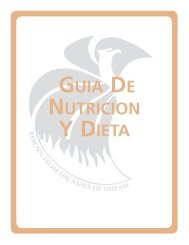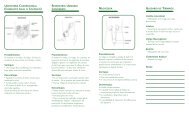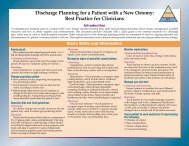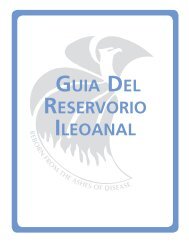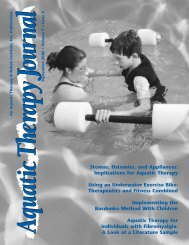Continent Diversion - United Ostomy Associations of America
Continent Diversion - United Ostomy Associations of America
Continent Diversion - United Ostomy Associations of America
You also want an ePaper? Increase the reach of your titles
YUMPU automatically turns print PDFs into web optimized ePapers that Google loves.
Ask Dr. Beck<br />
Dr. Beck is board<br />
certifi ed in General<br />
and Colon and Rectal<br />
Surgery and is a Fellow<br />
<strong>of</strong> the <strong>America</strong>n College<br />
<strong>of</strong> Surgeons and the<br />
<strong>America</strong>n Society<br />
<strong>of</strong> Colon and Rectal<br />
Surgeons. Dr. Beck<br />
conducts research into<br />
colorectal diseases,<br />
has authored and<br />
edited seven medical<br />
textbooks, written<br />
numerous scientifi c<br />
publications. Dr. Beck is<br />
a nationally recognized<br />
expert in infl ammatory<br />
bowel disease, anal<br />
cancer, adhesions,<br />
sphincter saving<br />
surgery for cancer, and<br />
laparoscopic surgery.<br />
Send questions to<br />
publisher@uoaa.org or<br />
P.O. Box 3605<br />
Mission Viejo, CA 92690<br />
Enlarging Stomas, Drainage, Lethargy and Watery Output<br />
Bathroom Trips<br />
I just had J-Pouch surgery six months<br />
ago and I am going to the bathroom 10-14<br />
times a day. Is there a way to reduce the<br />
number <strong>of</strong> trips to the bathroom?<br />
Dear New Patient,<br />
There are a number <strong>of</strong> measures that<br />
can be tried to reduce the number <strong>of</strong> bowel<br />
movements after creation <strong>of</strong> an ileoanal<br />
anastomosis. The fi rst option is dietary<br />
measures. Avoid foods that increase the<br />
number <strong>of</strong> bowel movements. Patients<br />
are helped by eating large breakfasts and<br />
lunches, then a small, early dinner.<br />
Taking additional fi ber helps many<br />
patients to form or bulk their stools.<br />
However, in some patients fi ber produces<br />
more bowel movements. Trial and error is<br />
the only way to fi nd how it will affect you.<br />
The next option is medication. These<br />
are usually added in a step-wise fashion.<br />
We usually start with Imodium (available<br />
over the counter) at 2-4 mg orally 30<br />
minutes before meals and at bedtime. The<br />
amount taken is gradually increased up to<br />
16 mg (eight pills) per day. Sometimes the<br />
liquid form is more effective initially than<br />
the pills.<br />
Next we add Lomotil (prescription) in a<br />
similar fashion: 1-2 pills orally 30 minutes<br />
before meals and at bedtime. The third<br />
drug used is codeine (30-60 mg) 1-4 times<br />
a day. The fourth medication is a morphine<br />
elixir (Roxinal) 5-20 drops 4 times a day.<br />
Other options that may help some<br />
patients is Bismuth (Pepto-bismol) or a<br />
binding agent such as Questran.(cholesty<br />
ramine).<br />
With some or all <strong>of</strong> these measures a<br />
patient’s bowel frequency can be reduced<br />
while their intestine and kidneys adapt to<br />
their new anatomy. This usually occurs<br />
over about 6 months. At that time we<br />
usually start reducing the medications the<br />
patient is taking.<br />
Excersing<br />
I had a Kock Pouch done about three<br />
months ago. I’d like to start running, cycling<br />
and swimming again, but I’m afraid I might<br />
hurt the pouch. Is there anything I should<br />
do to avoid problems? Are these activities<br />
safe with an internal pouch?<br />
Dear New Patient,<br />
Most physical activities are safe with<br />
a continent ileostomy. The major potential<br />
risk is either a blow to the abdominal wall<br />
or activity that transmits severe force to the<br />
body. An example would be a severe fall<br />
or a major automobile accident where the<br />
body is restrained (ie with a seat belt) but<br />
the force <strong>of</strong> the accident causes the pouch<br />
to be compressed or stretched.<br />
With signifi cant force, there is a risk the<br />
pouch could rupture or be torn away from<br />
its attachments to the abdominal wall. The<br />
chance <strong>of</strong> this happening is rare and can<br />
be minimized by emptying your pouch<br />
prior to engaging in physical activity.<br />
With an empty pouch, activities like<br />
running, cycling and swimming should be fi ne.<br />
Get Answers<br />
Do you have a question for Dr. Beck<br />
or Nurse Junkin? You can e-mail your<br />
question to publisher@uoaa.org or you<br />
can mail it to:<br />
The Phoenix Magazine,<br />
P.O. Box 3605, ission Viejo, CA 92690<br />
4 The Phoenix <strong>Continent</strong> <strong>Diversion</strong> New Patient Guide



